Are you curious about starting your own business powered by Artificial Intelligence? In this article, we'll show you how to turn your vision into reality and what you need to build an app with AI.
- What does the market of AI apps look like now?
- What’s the best way to start AI app development?
- Should you choose no-code/low-code or develop your app from scratch?
- Should you use a private LLM, open-source model or build your own?
- What are the costs of AI app development?
Find out the answers to your questions below. Discover the exciting journey of embracing the technologies of the future. technologies of the future.
How AI is used in mobile apps
Let’s start by discussing different ways you can apply the AI magic in your app.
There are a couple of dozen apps on your phone and most of them are using AI to offer some advanced functionality. Here are just a few possible use cases:
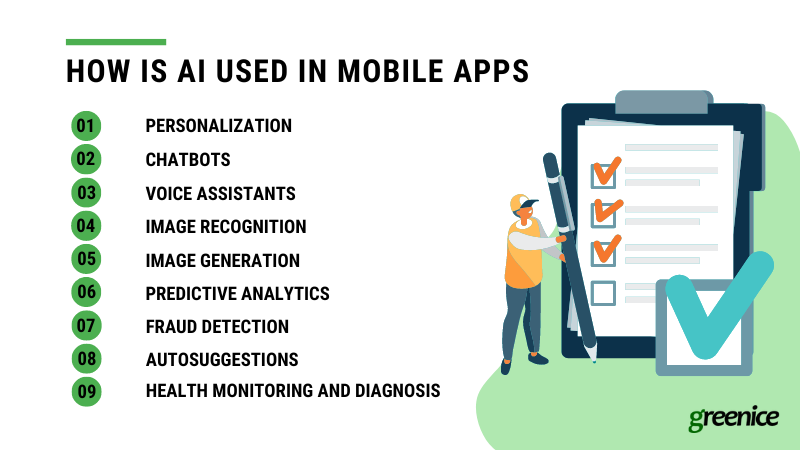
Personalization
An algorithm analyzes users’ data to offer the most suitable product or experience. This can be done as a product recommendation or customer segmentation. For example, Spotify picks songs you'll love, while Amazon shows you products you're interested in buying. Netflix suggests movies and shows based on what you've enjoyed before.
Chatbots
AI-driven NLP enables chatbots to understand and respond to human language more naturally and effectively. This technology underpins the functionality of virtual assistants and customer service bots, allowing for more human-like conversations. For example, Duolingo uses a chatbot to help users practice language skills through conversation.
Voice assistants
AI voice assistants control devices by following voice commands, and doing tasks like setting reminders or answering questions. Siri by Apple can send messages, make calls, or open apps after the user asks it to. 50% of U.S. mobile users use voice search daily, indicating the growing importance of virtual assistants.
Image recognition
This feature is a smart tech that helps computers understand and interact with photos and images just like humans do. For shopping, apps like BooHoo let you snap a photo to find similar products. The Planter app helps identify plants and care for them with just a picture. Navigation gets easier with Google Lens and Maps, guiding you with real-world images. Banking apps like GOmobile by BNP Paribas use this feature to verify user identity with face.
Image generation
AI image generation creates new visuals from textual descriptions or modifies existing images with artificial intelligence. Apps like Lensa, DALL-E, and FaceApp showcase this technology's capabilities. Lensa adds artistic touches to your photos, turning them into digital artworks. DALL-E generates unique images based on simple text prompts, bringing imaginative concepts to life. FaceApp alters photos to change a person's age, hairstyle, or expression.
Predictive analytics and risk assessment
AI helps businesses understand and predict user behavior, improving decision-making and minimizing risks. For example, the financial app Mint analyzes transaction histories and financial patterns to forecast future spending, suggest budgets, and alert users about potential risks like overdrafts or unusual transactions.
Fraud detection
Financial institutions use AI to analyze transaction patterns in real time to detect and prevent fraudulent activities. PayPal uses machine learning algorithms to identify potentially fraudulent transactions. Zelle incorporates AI-based systems to enhance security by analyzing user behavior and transaction patterns for signs of fraud.
Autosuggestions and autocorrections
AI improves typing efficiency by suggesting words and correcting errors. Google Search uses autocomplete to help users find information faster. SwiftKey offers an intelligent keyboard that learns from user input for better suggestions.
Health monitoring and diagnosis
AI analyzes health data from wearable devices or inputs to monitor health conditions or even diagnose diseases. Apple Watch detects irregular heart rhythms and can call emergency services if a fall is detected. Ada Health App offers a symptom checker powered by AI to suggest possible diagnoses.
Growth of AI apps in numbers
The excitement around AI apps is huge because they're changing how we use technology, making things smarter and more interesting. Let's look at why launching an AI app is a great idea, backed up by some really impressive numbers.
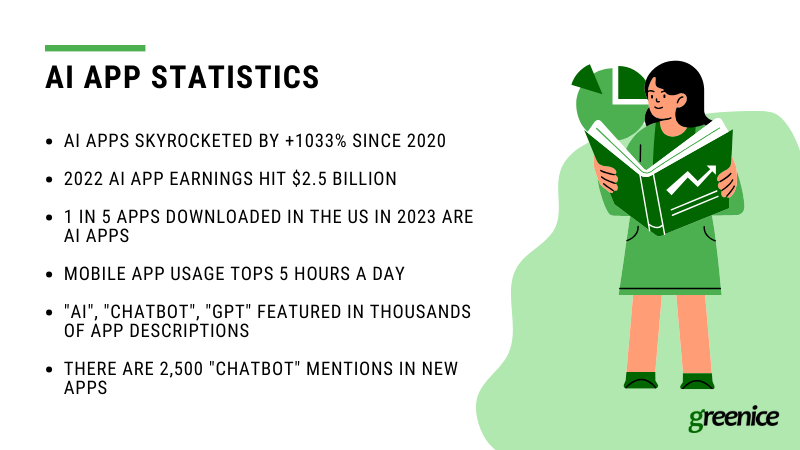
How fast AI apps are growing:
- Since 2020, the number of "AI" named apps in the App Store's Product category shot up by 1033%. This means a lot more AI apps are out there now.
- In 2023, the number of downloads for apps with AI features increased by 11% compared to 2022, reaching approximately 1.2 billion.
Money made from AI apps:
- In 2022, AI apps brought in $2.5 billion which shows that people are really into these apps.
- FaceApp, an app that uses AI, was the top money-maker with $100 million in 2022.
- In December 2023, consumer spending on AI apps increased to $12 million for AI chatbots and $10 million for AI art generators.
How much we use them:
- Siri, an AI assistant on Apple devices, is used by over 660 million people every month.
- In the first half of 2023, one out of every five AI app downloads originated from the United States.
- On average, people spent more than 5 hours a day on mobile apps in 2023.
Growth of specific AI features in apps:
- In 2023, thousands of new apps added "AI," "chatbot," or "GPT" to their descriptions, as it attracts users.
- Specifically, 2,500 new apps mentioned "chatbot" in 2023 – that's a lot more than in the last four years combined!
These numbers show that AI apps are not just a trend; they're a big part of our digital world, making everything from chatting to managing finances easier and more fun. But what is more important is that people are eager to use such apps.
Top AI apps
Let’s look at the most popular apps recently (according to Business of Apps):
| Name | Category | Description |
| ChatGPT (by OpenAI) |
Productivity/Entertainment |
ChatGPT emerged in 2022 as the quickest to gain popularity in consumer software history. It engages users in human-like conversations by remembering earlier interactions and even generates pictures. |
| Alexa (by Amazon) |
Productivity |
Alexa serves as a cloud-based virtual assistant capable of managing certain smart home devices, playing music, setting alarms, delivering real-time information, and organizing tasks. |
| ELSA Speak (by ELSA Corp) |
Education |
ELSA offers a digital platform for English language learning, providing instant feedback on pronunciation through brief dialogues. |
| FaceApp (by FaceApp Technology Limited) |
Entertainment |
FaceApp is a photo manipulation application that provides users with AI-powered filters, backgrounds, and effects to alter facial images. |
| Google Assistant |
Productivity |
Google Assistant is accessible on both mobile and smart home devices, supports interactive conversations with users and helps them manage a variety of tasks. |
| Lensa (by Prism Labs) |
Entertainment |
Lensa allows users to enhance photos with retouching, blurring, and various special effects. |
| Bing AI (by Microsoft) |
Productivity |
Bing AI, built on OpenAI's GPT-4 model, is equipped to generate content, fetch online information, and create artwork, all while referencing its sources. |
| Otter AI (by Otter AI, Inc.) |
Productivity |
Otter AI integrates Artificial Intelligence to offer automated transcription of meetings, capturing notes and slides efficiently. |
| Siri (by Apple) |
Productivity |
Siri responds to queries and executes commands, tailoring its interactions based on the user's language preferences and habits. |
| Socratic (by Google) |
Education |
Socratic assists students by offering educational materials in response to photos of their homework questions. |
| Dream (by WOMBO) |
Entertainment |
WOMBO Dream generates artwork from user inputs, exploring a variety of artistic styles. |
Steps to build an AI app
Diving into the world of AI app development can feel like navigating a maze without a map—exciting, yet daunting. But what if you had a step-by-step guide to illuminate the path from concept to creation? Let's explore the blueprint that can turn your AI app idea into a reality, making the journey not just manageable, but truly exhilarating.
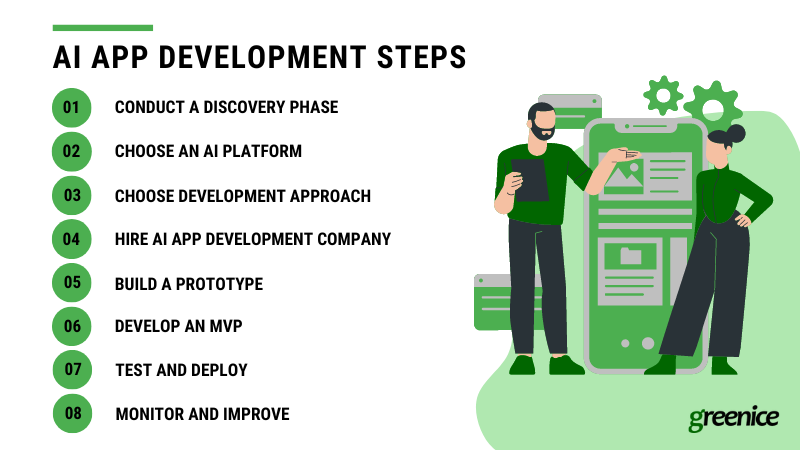
Below are the steps you will need to take to create a successful AI business.
Conduct a Discovery phase
Launching an AI mobile app without first research and planning is risky. The discovery phase helps ensure your app solves a real problem effectively, like Spotify using AI to create personalized playlists.
How to conduct the Discovery phase:
- Research: Understand the market, identify and analyze competitors, and define the business challenges your AI aims to solve. Use tables to compare features, user base, pricing, etc. Ask questions like, "What specific problem are we solving?" and "What outcomes do we expect?" You can also build an Ideal Customer Profile (ICP) to understand who will use your app and their pain points.
- Define: Specify the problem clearly and ensure it’s significant enough to justify the investment. Make sure the problem allows for scalability as your app grows. During this stage you will develop a Unique Value Proposition (UVP) that highlights how your app is different and better than others and decide on your business model, considering what customers are willing to pay and what competitors offer.
- Describe: Outline what your app will do. This includes defining user types, creating user flow diagrams, and detailing the app’s features and wireframes.
- Plan: Organize how to develop your app. Prioritize features, plan the development roadmap, set milestones, and create a timeline.
During this process, you will develop a Software Requirements Specification (SRS), an exhaustive document that outlines all facets of your upcoming project. This SRS acts as a roadmap, steering the development efforts to match your vision and goals, guaranteeing that your chatbot achieves its designated function efficiently.
Choose an AI platform for your project
So you know what app you want to create, but what AI technology is the most suitable? You have 3 options - AI as a Service, open-source AI models, custom AI development. Let’s explore each of them:
- AI as a Service (AIaaS), offered by platforms like OpenAI's GPT and Google’s Gemini, provides easy access to AI capabilities without the need to develop an LLM model yourself or even take care of the infrastructure development. It's user-friendly and cost-effective initially but raises concerns over long-term expenses and data privacy. It’s suitable for quick deployment with minimal technical effort and when pre-trained models align with your needs.
- Open-source AI models, such as those from Hugging Face, offer extensive customization and community support, appealing for their flexibility and cost savings. However, they demand technical expertise and maintenance costs. It’s suitable for projects needing customization with available technical expertise to modify these models.
- Custom AI development allows for tailor-made solutions that offer a competitive edge for unique projects. This approach grants full control but requires significant resources, time, and expertise. It’s suitable for unique requirements or competitive advantage, requiring more resources but offering full customization.
Picking the right platform really comes down to what your project specifically needs and what resources you've got. Let's try to clear things up a bit with a few questions:
- What does your app need to do in terms of features? E.g., if you need a system that can produce pictures and text then you need a multimodal technology like GPT-4 or Gemini, which you can integrate as AIaaS.
- How fast are you looking to get AI features up and running? E.g., if you want it as fast as possible then choose AIaaS as it offers a ready solution.
- What kind of skills and resources do you already have for building this out? E.g., if you are not a professional developer then bespoke and open-source models will be too complicated for you to work with without a team.
- How much do you need to tweak things to make them just right for you? E.g., if your project requires very specific then you need to search for options with more customization available.
- Are there any special needs your software has to meet? E.g., if it needs to be HIPAA compliant to serve patients then some AIaaS will be a bad fit.
Answering these questions will help you understand if you need some simple and easy-to-build solution, or if your project requires unique functionality of custom development only.
We can help you choose the right AI strategy
Choose development approach: app builder vs custom mobile app
Besides choosing your AI strategy you’ve another choice to make: low code/no code solutions and custom development. Do you want to create something almost for free in just a few days, or dive into the deep end with a custom project that could cost a pretty penny and take months? Why would anyone go for the pricier, longer route? Let’s break it down and see why you might pick one over the other.
App builders are like the fast food of app development. They’re quick, easy, and don’t need you to be a pro coder to get something on the table. Perfect if you're tight on money or time and just need the basic functionality. There are a myriad of options, e.g. Softr for complete beginners or Microsoft PowerApps for a little more advanced users. The downsides are limited functionality, performance, and customization.
Custom mobile app development implies building everything from the ground up. It's all about making exactly what you want and how you want it. You can get super fancy with the tech and make sure your app stands out. The downside is that it will cost more and take longer.
Additionally, within custom development, you've got two choices - cross-platform and native. Cross-platform is a bit of a middle ground; develop once, run anywhere. It saves time and cash if you’re trying to hit both Android and iOS users. Native development, on the other hand, is tailor-made for each operating system, squeezing every bit of performance and making sure your app feels right at home on each device. The latter means more development time is needed.
However, there is a trick that makes custom mobile apps more affordable - white-label solutions. This option allows you to use pre-written apps with native or cross-platform technologies that can be used as a basis for your app and customized to your needs. This significantly reduces the development time and, thus, the costs, without sacrificing the flexibility and customization compared to no code options. Based on our experience this can be a very efficient alternative for those with some technical skills.
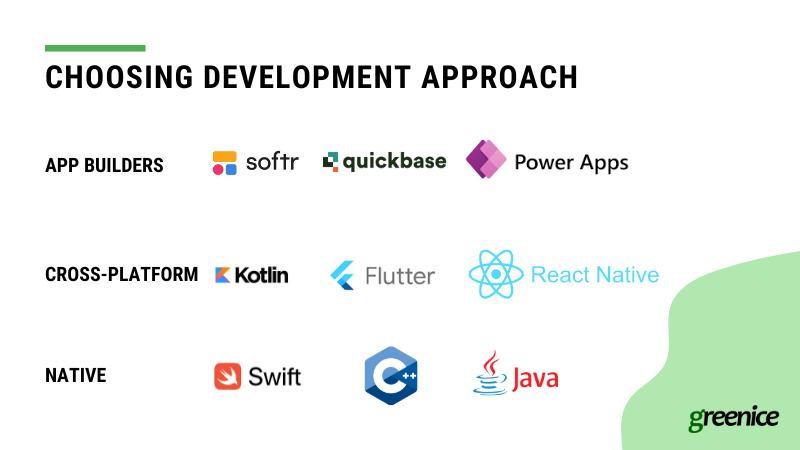
In a nutshell, if you're just testing the waters or need something simple without breaking the bank, app builders are your best bet. But if you're aiming to really make a unique product, or need your app to perform high-tech feats, custom development is the way to go. It's all about matching the approach to your appetite (and budget). At the same time, white-label solutions can help to save time and money while choosing custom development.
Need help to choose the right technology?
Hire AI app development company
Searching for an AI app development services & company can be daunting. It's not just about finding folks who know their way around Artificial Intelligence, machine learning, data science, and software development. You want a team that's experienced in creating AI solutions, sure, but they also need to tick a few more boxes.
Look for a team that's not just smart but also great at staying in touch and has polished processes. Communication is key, especially when they're not in the room with you. You'll want a team with clear and transparent processes—no guessing games about what they're doing or when your project will be ready.
Peek at their portfolio and ask for references; it’s like checking a chef’s reviews before booking a table. How they've handled projects in the past can give you a good taste of what to expect. Interaction is another vital thing. You should be able to chat with the team directly, throw in your two cents, and truly influence the project's direction. After all, it's your vision they're bringing to life.
Choosing the right outsourced team is about more than just their tech chops. It's about ensuring they're a perfect blend of expertise, communication skills, and a transparent, collaborative spirit to turn your dream app into reality.
Build a prototype to test your idea
How to ensure that your innovative idea can be executed with existing technologies? How to check if your idea is viable? The best way to find out is through some hands-on R&D where you can experiment with different models (including LLMs) and strategies side-by-side. This means creating prototypes to test your theories quickly and without breaking the bank.
Take our AI tutor project as an example. It needed to flawlessly recognize handwriting and graphics from pictures. To tackle this, we built a proof of concept (POC) and put various OpenAI models through their paces. By comparing how well they performed and how much they cost to run, we pinpointed the perfect model for our project's demands.

Develop an MVP
After you have tested the prototype and found the best solution - it is time to create the first iteration of your product to try it on users. This is possible by building a Minimal Viable Product (MVP).
Think of an MVP as the simplest version of your app that you can actually let people use. It's got enough features to work but is still basic. This step is different from making a prototype because a prototype is just to see if your idea can work, while an MVP is a working version you give to real users.
For an AI mobile app, creating an MVP means picking the most important features your app needs to solve the main problem it's designed for. You build those core features, making sure the AI part of your app does what it's supposed to do, like recognizing images or understanding voice commands.
Then, you launch this simple version to the group of users. This lets you see how users interact with your app, what they like, and what could be better. Using their feedback, you can make your app even better before releasing it to everyone.
Test and deploy
Your project is about to go out in the wild. Testing is key to ensuring your AI mobile app runs smoothly from start to finish. This means checking everything from user interactions to AI performance and final output. Performance testing is also crucial to ensure your app can handle the load.
The deployment phase gets your app into users' hands via the App Store and Play Market, with App Store Optimization (ASO) ensuring it's discoverable. Launching your app is a significant step, transitioning from development to practical use. It’s where you start seeing how your app stands up in the real world and begin gathering initial user reactions for future improvements.
Monitor and improve
Keeping your AI mobile app sharp and effective means you can't just launch it and forget it. After launching an MVP you have some feedback to understand how to improve your product, and what features to add or remove.
This iterative process is essential, particularly because of how fast AI evolves and user needs change. This is what the monitoring and maintenance phase is for - to keep a close eye on how your app is doing, using tools like Google Cloud Monitoring and TensorBoard to spot and fix any dips in performance or bugs.
For those using open-source AI, the developer community is a goldmine of updates and fixes to keep your app on track. If you're using AI as a Service (AIaaS), the heavy lifting of maintenance is mostly handled by the service provider. But, if you've gone the custom AI route, your team needs to roll up their sleeves for regular updates and troubleshooting.
No matter the approach, staying proactive with monitoring and updates is key to keeping your AI mobile app relevant and performing well. Plus, with AI tech constantly advancing, encouraging your team to keep learning and adapting is crucial for staying ahead in the game.
AI app development cost
Building an AI mobile app isn't a one-size-fits-all affair when it comes to costs. Several key factors play into the final price tag: features complexity, AI strategy, app development approach, and design.
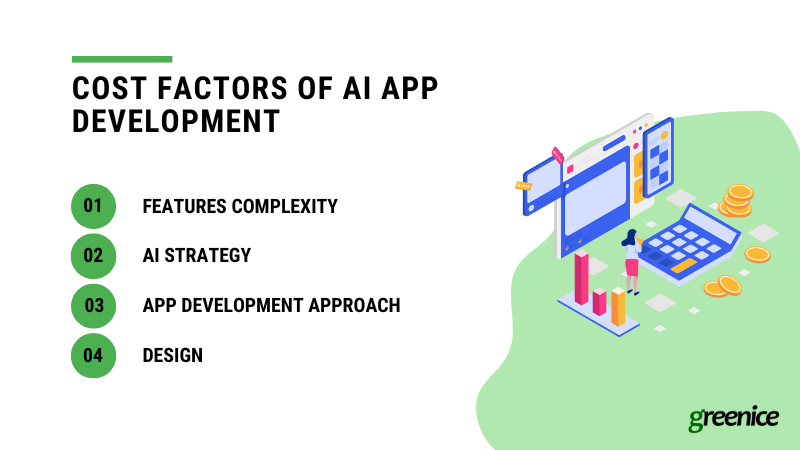
Features complexity
The more complex your app's features, the higher the cost. Fancier features, such as advanced natural language processing, real-time machine learning analytics, or complex image recognition capabilities, typically lead to higher costs. This happens largely because these functions often require extensive research and development (R&D) to tailor solutions that meet specific client needs.
For instance, developing an AI app that can accurately interpret and respond to human emotions through voice and facial recognition demands not just advanced AI capabilities but also pioneering R&D efforts to achieve reliable, effective results. As you add these complex features, the need for specialized expertise and additional development time escalates, thus increasing the overall project budget.
It's also important to consider the quality and expertise of the development team when determining the cost, as investing in a capable team can lead to a more successful and efficient project in the long term.
AI strategy
When deciding on an AI strategy, it's important to consider the different models and services available, each with unique cost structures and usage details. From AIaaS platforms with free initial tiers to open-source models that incur development and operational expenses, here’s a quick overview of some popular AI models and their costs to help you make an informed choice:
AIaaS: Using platforms like Amazon Lex might start with free tiers but then move to pay-per-use models, which can add up depending on usage. Most LLMs are using a token system. Here are some popular models for example:
- Amazon Lex: starts free, then $0.004/text, $0.0065/speech.
- GPT models: from $0.0005/1k input tokens, $0.0015/1k output.
- Dall-E image-generation: from $0.016/image for 256×256 resolution
Open-source models: While there's no initial cost for the models themselves, the development and operational expenses (including server costs) for customization can significantly increase the overall budget. For example, models from Hugging Face are free, with infrastructure costs starting from $5/storage, $0.06/hour for endpoints.
Bespoke AI: In general, custom AI solutions are the most expensive, potentially adding tens of thousands of dollars to development costs due to the need for specialized research and development. Creation of your own powerful LLM similar to GPT models might cost billions of dollars. At the same time, smaller task-specific models can be much more affordable. For example, we created a machine learning price recommendation feature for a marketplace and it took only a month and around $10K.
App development approach
When developing your AI mobile app, you have several options to consider, each catering to different needs and budgets: app builders (no-code or low-code), white-label solutions, and custom development (cross-platform or native).
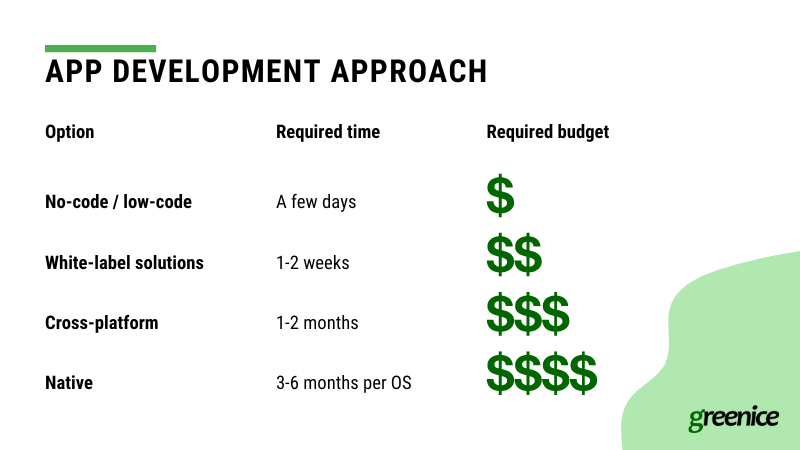
App builders: the most affordable options, they offer less customization and may not fully support complex AI features. The pricing varies from free options to different subscriptions and expensive variants.
Custom development: is the most flexible yet expensive option. Native apps (built specifically for iOS or Android) may cost more individually but offer the best performance and user experience. Cross-platform apps provide a cost-effective middle ground.
White-label solutions are a great alternative to custom development in terms of budget, as pricing may start from $5,000 for a cross-platform app (this price doesn’t include AI functionality).
Design
A critical yet often overlooked factor, the design can account for a significant portion of the development cost. A high-quality, user-friendly design can increase the cost by 15% to 50% but is crucial for user engagement and retention. According to UpWork, the average hourly rate of designers is $25-39.
Still wondering about the total cost after adding everything up?
Example: AI image app cost
Let’s take an example from our experience.
We developed a unique app using React Native and Dall-E model that lets you upload and modify images through simple text commands, e.g. adding accessories or drawing a cat. This intuitive app processes the requests using AI, effortlessly transforming images. The cost of developing a project like this starts between $10,000 and $15,000.
Our experience with AI app development
We, at Greenice, have gained valuable experience in the AI application development services. Here are a couple of our projects.
Mobile app with Dall-E integration

We created an app that lets you edit images using words. With Dall-E integration, you can upload an image and choose what you want to add or change - like adding an accessory or drawing a cat. It's an easy and fun way to make your images look exactly the way you want them to be. The user just types your request, and the Artificial Intelligence will do the rest.
Arcbazar
Working alongside Arcbazar, we dedicated our efforts upgrading their online designer marketplace by optimizing existing code for better performance and ease of use. We expanded its global reach by adding support for 10 languages and 13 currencies. A notable addition is the machine learning-based award recommendation feature, which suggests awards based on user activity to enhance engagement and satisfaction, making the platform more interactive and user-centric.
Greenice virtual assistant

To boost our website's customer support, we introduced a chatbot powered by GPT-4. It's crafted to offer detailed advice about our services and arrange meetings with clients effortlessly. The chatbot is equipped with a custom phrase library for Greenice, guidelines for interactions, and functionalities for tasks like quoting prices and booking appointments. It excels in understanding user questions and providing accurate, helpful answers, greatly enhancing the customer service experience.
Amazon Lex bot
For a client offering a SaaS platform for virtual clinics, we created an advanced chatbot with Amazon Lex for written conversations and Amazon Connect for voice interactions, simplifying the process of booking doctor appointments and symptom checking. This bot features both pre-programmed and customizable responses and can transfer users to a live agent when needed, ensuring a smooth user journey. Its AI-driven conversation skills deliver pertinent advice and gather feedback after each service, improving the overall quality of care.
Conclusion
In this article, we explored the steps involved in building an AI app, highlighting the benefits of integrating artificial intelligence into your business. From the discovery phase through to launching an MVP, and selecting the right team and technologies, these steps are key to a successful AI implementation. It's important to consider the development time, strategy, and technology used, as these factors directly influence costs and outcomes.
Our experience has shown that with a well-defined strategy and a skilled team, AI can significantly transform your business processes. There's no need to replicate existing solutions like ChatGPT or MidJourney. Instead, focus on identifying and addressing unmet needs with innovative solutions. We offer comprehensive technical consultation, requirement identification, and custom project development.
If you're ready to tame the potential of AI and create impactful experiences, we're here to help.
Looking for an AI app development company?
Rate this article!
5







 Sign in with Google
Sign in with Google
Comments (0)